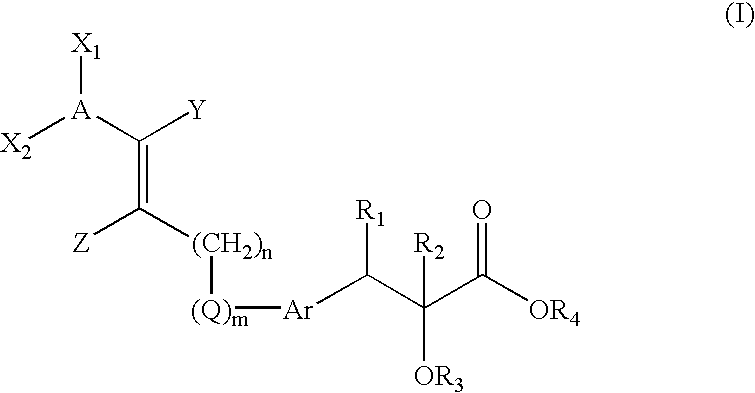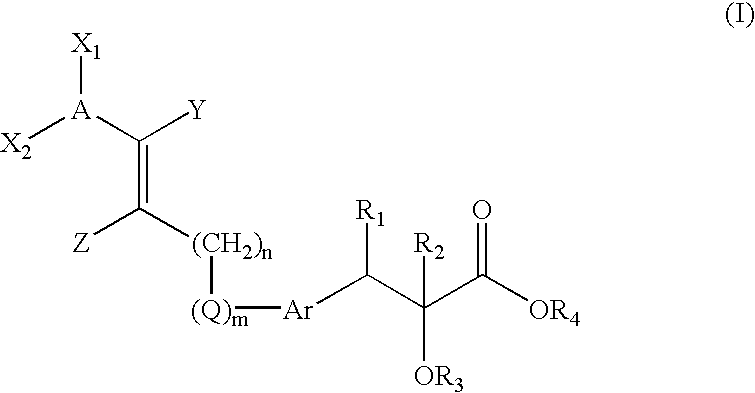Compounds, their preparation and use
a compound and compound technology, applied in the field of compound, can solve the problems that the single approach to lowering glucose does not overcome macrovascular complications, and achieve the effect of great potential
- Summary
- Abstract
- Description
- Claims
- Application Information
AI Technical Summary
Benefits of technology
Problems solved by technology
Method used
Image
Examples
example 1
(E)-(S)-Ethyl 3-[4-(3-biphenyl-4-yl-but-2-enyloxy)-phenyl]-2-ethoxy-propionate
a)
Sodium (1.75 g, 73.4 mmol) was added to ethanol (45 ml) at 20° C. and the mixture stirred until the metal had fully reacted. Triethyl phosphonoacetate (14.69 g, 73.4 mmol) was added, the mixture stirred for 5 min., then 4-acetylbiphenyl (12.00 g, 61.1 mmol) was added to the stirred solution. The mixture was stirred at room temperature for 24 h, the resulting suspension filtered, and the filter-cake collected and recrystallised from ethanol to give (E)-3-biphenyl-4-yl-but-2-enoic acid ethyl ester as white crystals; 5.73 g (36%)
1H NMR (300 MHz, CDCl3) δ: 1.32 (3H, t), 2.62 (3H, d), 4.21 (2H, q), 6.2 (1H, d), 7.31-7.65 (9H, m). MS: 267 (M+), 266(100%), 221, 194, 178. Microanalysis Calculated % C, 81.00; H, 7.0. Found C, 80.86; H, 6.90.
b)
A 1M solution of DIBAL-H in toluene (40 ml, 40 mmol) was added dropwise at −70° C. over 20 min. to a stirred solution of 3-biphenyl-4-yl-but-2-enoic acid ethyl ester (2.66 g...
example 2
(E)-(S)-3-[4-(3-Biphenyl-4-yl-but-2-enyloxy)-phenyl]-2-ethoxy-propionic acid
Sodium hydroxide (1M, 0.45 ml, 0.45 mmol) was added to a solution of (E)-(S)-ethyl 3-[4-(3-biphenyl-4-yl-but-2-enyloxy)-phenyl]-2-ethoxy-propionate (example 1) (0.100 g, 0.225 mmol) in ethanol (20 ml) and the mixture stirred at 70° C. for 2.5 h. After cooling to room temperature the resulting mixture was partitioned between water (50 ml) and ethyl acetate and the aqueous phase collected. The aqueous phase was acidified with 1N hydrochloric acid (5 ml) and extracted with ethyl acetate (100 ml), and the organic phase collected, washed with brine, dried (Na2SO4) and evaporated to give (E)-(S)-3-[4-(3-biphenyl-4-yl-but-2-enyloxy)-phenyl]-2-ethoxy-propionic acid as a white solid; 0.014 g (15%).
1H NMR (300 MHz, CDCl3) δ: 1.19 (3H, t), 2.63 (3H, d), 2.93 (1H, dd), 3.1 (1H, dd), 3.4-3.65 (2H, m), 4.1 (2H, q), 4.72 (2H, d), 6.1 (1H, dt), 6.9 (2H, d), 7.2 (2H, d), 7.35-7.60 (9H, m).
example 3
(E)-(S)-3-{4-[3-(4′-Bromo-biphenyl-4-yl)-but-2-enyloxy]-phenyl}-2-ethoxy-propionic acid ethyl ester
a)
(E)-3-(4′-Bromo-biphenyl-4-yl)-but-2-enoic acid ethyl ester was prepared from 4-(4-bromophenyl)acetophenone (12.0 g, 0.044 mol), sodium (1.25 g, 0.052 mol) and triethyl phosphonoacetate (11.73 g, 0.052 mol) by a procedure analogous to that described in example 1a yielding 11.97 g (80%).
1H NMR (300 MHz, CDCl3) δ: 1.32 (3H, t), 2.61 (3H, d), 4.23 (2H, q), 6.19 (1H, d), 7.40-7.58 (8H, m).
b)
(E)-3-(4′-bromo-biphenyl-4-yl)-but-2-en-1-ol was prepared from (E)-3-(4′-bromo-biphenyl-4-yl)-but-2-enoic acid ethyl ester (3.45 g, 10.0 mmol) and DIBAL-H (1M in toluene, 40 ml, 40 mmol) by a procedure analogous to that described in example 1b, yielding 1.68 g (55%).
1H NMR (300 MHz, CDCl3) δ: 2.14 (3H, d), 4.4 (2H, t), 6.05 (1H, dt), 7.45-7.55 (8H, m),
c)
The title compound was prepared from (E)-3-(4′-bromo-biphenyl-4-yl)-but-2-en-1-ol (0.364 g, 1.2 mmol), triphenylphosphine (0.328 g, 1.3 mmol), diethyl...
PUM
| Property | Measurement | Unit |
|---|---|---|
| resistance | aaaaa | aaaaa |
| affinity | aaaaa | aaaaa |
| energy balance | aaaaa | aaaaa |
Abstract
Description
Claims
Application Information
 Login to View More
Login to View More - R&D
- Intellectual Property
- Life Sciences
- Materials
- Tech Scout
- Unparalleled Data Quality
- Higher Quality Content
- 60% Fewer Hallucinations
Browse by: Latest US Patents, China's latest patents, Technical Efficacy Thesaurus, Application Domain, Technology Topic, Popular Technical Reports.
© 2025 PatSnap. All rights reserved.Legal|Privacy policy|Modern Slavery Act Transparency Statement|Sitemap|About US| Contact US: help@patsnap.com



